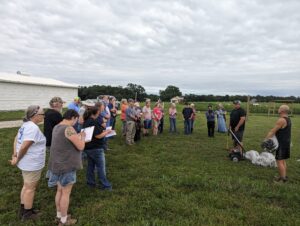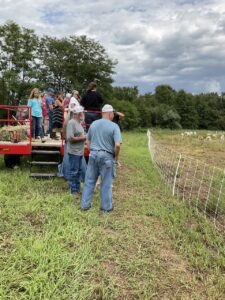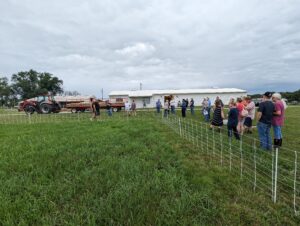Progress report for ONC23-116
Project Information
Silvopasture is the production practice that integrates trees, pasture, and livestock production together to maximizes income from multiple harvests at the same time. Apart from economic benefits, silvopasture has potential to sequester carbon from the atmosphere, preserves soil quality, balances forest ecology, and promotes environmentally sustainable production practices (Jose & Dollinger, 2019).
Missouri is a home for 15 million-acres of forest, and 17 million-acres of pasture, providing huge possibilities for a silvopastoral-system of livestock production (ECS-MAF, 2021). In the state, sixty-four thousand agricultural producers (86% of the total) are small farmers with less than $25,000 gross sales per year (MA-SBA, 2021). Silvopastoral system of livestock production can maximize the income of small farmers by using available forest and pastureland, while maintaining environmental biodiversity and minimizing effects of climate change.
Sheep and goat enterprise can be started in a small farm with small breeding stock. Animals reach slaughter size quickly, can be raised on forage alone, and investment can be paid fast. Thus, it can be an excellent enterprise for small farmers and low-income producers. The objective of this program is to train producers on fencing in the silvopasture for sheep and goat production across Missouri.
The overall objective of this project is to make small-farmers able to start sheep and goat production in the silvopasture. Our specific objectives are:
- Provide onsite demonstration for building a portable electric fence and water system in silvopasture.
- Familiarize farmers with different types of fences [permanent (border) and temporary (inside to create sub-paddock)], water-systems, forages, and trees.
- Help farmers become aware of different energizers (battery powered systems, solar rechargers, and AC powered units), how to troubleshoot including risk of falling branches from trees, and
- Provide book, extension factsheets, booklets, and information on local fencing suppliers.
Cooperators
Educational & Outreach Activities
Participation summary:
Hands-on training on, ‘setting up small fences for sheep and goats’ was organized at Four oaks farm located in E Judy school Road. Ms. Glenda Deshon and her Son Justin Deshon manages 300 acres of pasture partly covered with trees and shrubs using 200 head of mixed goat breeds. Ms. Glenda Deshon is a Goats On the Go® affiliate for Boone and Cole County.
Our program started with hands-on-training on setting fence (electric net) in the silvopasture for strip grazing sheep and goats. The idea was to use goats for the control of noxious weeds, brush, and invasive plants. Herbicides if used to control such plants can run off and therefore are dangerous. Power equipment burns fossil fuel and produces CO2 whereas goats used for the same purpose won’t leave anything behind except fertilizers. Goats used to control vegetation have little damage to desirable plants. Goats have light foot and there is no risk of soil erosion. Seeds of plants after eaten by goats are not viable and therefore no risk of dispersion.
30 Participants got an opportunity to learn how to set up fence and where to buy supplies. After the practical demonstration Ms. Glenda provided in depth lecture on vegetation estimate before grazing, number of animals per acre, breed types, age of the animal appropriate for brush control. Her lectures concluded on how to avoid toxic plants for goats and treatment if accidentally consumed by goats. Increase in knowledge was evaluated immediately after the training program.
Learning Outcomes
Participants learned, where to buy electric net, solar chargers, fence checker, Cost of installing a solar fence charger etc. They know how to check fence voltage and other inspection. How to set voltage (appropriate place to keep charger). Advantages and disadvantages of electric net, 3-4 strand polywire fence, woven wire, barb wire, which company sells such supplies. Can you talk volt, height above the ground for lowest wire, fence net, what to do when it rains. Talk about labor cost. And what will happen when the sky is cloudy for a long time that inhibit charging of solar charger ?
Participants learned vegetation estimation for grazing (How long can we graze in that plot and when to move animals). How do you set waterer, mineral feeder, do you need to grain feed?, Water management, shelter (portable shade). How to check if goats are impatient or restless - for moving to next pasture. When to tear down the old fence and install new place? How often should I check pasture? How to determine when to move to a new pasture? Evening regular check list What are the preferred browse species (weeds and invasive plants)? How many animals per acre do you recommend for bush control from May to July 31st?What is the best age of animals/goats to start brush control? Important plants, browse species, and trees for silvopasturol grazing. Do you need to plant new forage in silvopasture (pasture with trees, woodland)? Targeted grazing to control invasive and nuisance plants? Benefits of rotational grazing, short grazing, repeat grazing? How to avoid toxic plants? How do you treat poisoned goats at home?
How much room animal need to have? Number of animals per area? What kind of goats are best for targeted grazing? What breeds do you recommend?
What about dwarf and pygmy goats for brush control? Where should I buy goats? How much do goats cost to buy? How much do goats cost to feed? Where to buy? What sex (male or female) to use for brush control? What won’t goats eat when they do targeted grazing? How to avoid toxic plants?
What are the health issues you encounter? What is vaccination schedule? Do you have to do hoof trim? Do I need guard dogs, donkeys, or llamas? How to save from predators? Do you prefer purebred or crossbreed? What is your view on using animals with horns, aggressive bucks, castrated or not castrated, females or males, age etc. for brush control? Will goats be able to completely clear the brush after finishing browsing?


